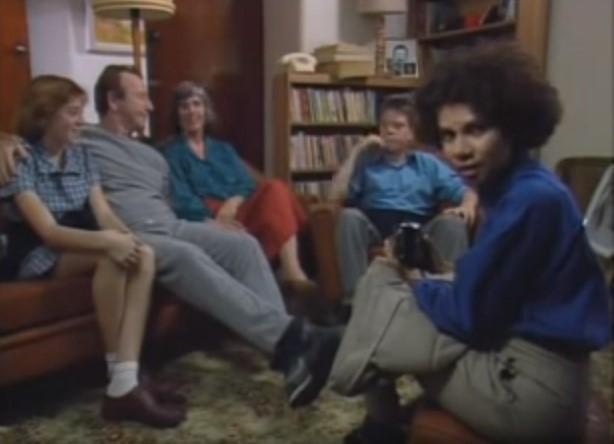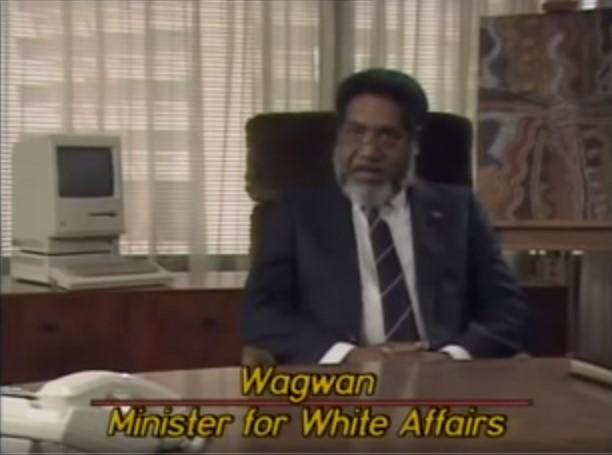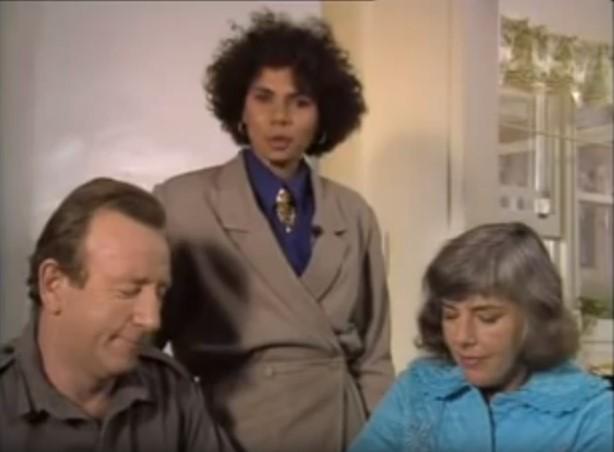
'Babakiueria': How a mockumentary fights against Orientalism
Orientalism is one of the dominant discourses of the West. The Mockumentary Babakiueria (1986) is able to show that this is really just a version of reality created by the dominant parties in society.
Orientalism turned upside down
Imagine the following scenario: instead of Europeans colonizing and oppressing Aboriginal Australians, it was Aboriginal Australians who invaded the country and dominated native white Australians instead. The mockumentary Babakiueria (1986) tells an alternative story of Australia’s history and present day through role-reversal, in which Aboriginal Australians are the colonizers and white Australians are the ones being colonized. A mockumentary, in short, is a fictional representation that makes use of documentary aesthetics with the urpose of mockery, parody, and/or satire.
Most analyses and reviews have focussed on the mockumentary’s criticism of the race relations in Australia. Even though it is true Babakiueria’s main focus lies with this specific criticism, none of these analyses and reviews have emphasized the wider discourse that forms the base of unequal race relations: the Orientalist discourse of the West. Interestingly enough, Edward Said’s (1935-2003) ground-breaking book Orientalism (1978), in which he introduces the term ‘Orientalism’ for the first time, was written only 12 years before the mockumentary was made.
In this book, Said (2003 [1978], p. 2) describes three interdependent definitions of Orientalism: general, academic, and historical and material definitions. In order to grasp the meaning of the term, let’s start with the first general definition: it is ‘a style of thought based upon an ontological and epistemological distinction made between ‘’the Orient’’ and […] ‘’the Occident’’ [the ‘Occident’ meaning white people in the West and the ‘Orient’ meaning non-white people outside the West].’ This means that a ‘very large mass of writers, among whom are poets, novelists, philosophers, political theorists, economists, and imperial administrators, have accepted the basic distinction between East and West as the starting point for elaborate theories, epics, novels, social descriptions, and political accounts concerning the Orient, its people, customs, ‘’mind’’, destiny, and so on’ (Said, ibid, pp. 2-3).
The book turned out to have a great impact upon cultural studies, postcolonial studies and other academic fields up until today: it shed a light on how white people in the West have talked about and created stereotypes of the Orient since colonial times, which led to the strengthening of Europe’s culture and identity (Said, ibid, p. 3). Therefore, Orientalism has been, and often still is, the white West’s strongest weapon in remaining in power worldwide.
It would not come as a surprise if Said’s innovative thoughts with Orientalism at its core had also influenced some creative minds in the film industry. Therefore, it is interesting to analyse Babakiueria (1986) in the context of this way of thinking in the cultural field from the 1980s on. How, then, does this mockumentary fight the Orientalist discourse in the representation of Aboriginal Australians?
Mockumentary
Babakiueria starts with the first encounter of Aboriginal Australians with ‘original’ white Australians in Australia. In this scene, the colonizers arrive with their boats and ask the white Australians, who are having a barbecue, how they call this land. ‘’This is a barbecue area,’’ one man replies. ‘’They call this BarbeKiueria. Nice, native name. Colourful. I like it!’’ one of the colonizers says. The film skips to then present-day 1980s and continues to show the contemporary Aboriginal struggles through role-reversal: the white people are being oppressed by society and the government.
The film is presented as a documentary led by reporter/ethnographer Duranga Manika who follows the lives of the white family Smith by observing, interviewing and talking about them (figure 1). Her intentions seem good, but she is totally ignorant of the social and historical context and is part of the Orientalist discourse herself, which results in humorous situations.

Figure 1
Why would the director, Don Feathertone, choose for a mockumentary in order to attack the Orientalist discourse of the West? How does humour play a part in this? As Lipkin et al. (2006, p. 13) pointed out, mockumentaries ‘perform the useful function of ventilating issues of concern in current affairs and drawing attention to the nature of media representation’. Humour is used in order to criticize the documentary as a screen form, documentary practitioners, and cultural, social and political icons (Lipkin et al., 2006, p. 14).
As we will see, Babakiueria takes several documentary modes, social issues and people in power as its objects of parody. Despite the humorous side of mockumentaries, the film's main criticism does not get lost as they ‘seek to develop a relationship with a knowing audience who through being in the joke can appreciate both the humor and the inherent critical reflexivity of the form’ (Lipkin et al., 2006, p. 14).
Orientalist discourse, power, and stereotypes
According to Said, one should not assume that Orientalism is merely a structure of lies and/or myths - a European fantasy of the Orient. Instead, it is 'a created body of theory and practice in which, for many generations, there has been considerable material investment', which is linked to socio-economic and political institutions (Said, 2003 [1978], p. 6). The second definition, then, is more historically and materially defined. Said (ibid, p. 3) describes this meaning as ‘the corporate institution for dealing with the Orient – dealing with it by making statements about it, authorizing views of it, describing it, by teaching it, settling it, ruling over it: in short, Orientalism as a Western style of dominating, restructuring, and having authority over the Orient’.
This definition has to do with power and power relations. Said makes clear that Orientalism is a discourse – using the definition of ‘discourse’ as described in Foucault’s The Archaeology of Knowledge (1969) and Discipline and Punish (1975). Only if we describe Orientalism as a discourse, ‘the enormously systematic discipline by which European culture was able to manage – and even produce – the Orient politically, sociologically, militarily, ideologically, scientifically, and imaginatively’ can be explained (Said, ibid, p. 3).
According to Foucault (as described in Rose, 2001, p. 137), the power of discourse lies in the fact that discourse is productive: discourse gets human subjects into certain ways of thinking and acting. This means that the Orientalist discourse makes people think about the Other only in very specific ways that are made available to them through the discourse. At the same time, humans are not forced into thinking and behaving this way.
Foucault argues that this is what makes discourse especially powerful: it gets people to behave and think in particular ways without repressing them; it does not function as a sort of ‘police’ that imposes rules for human thought and behaviour. Instead, our sense of ‘self’ and thus our sense of the ‘other’ are produced through discourses. The same is true for relations, places, objects, scenes, etc. This makes the distinction between the Occident and Orient ‘normal’ to people. As Rose (2001, p. 137) puts it, ‘discourse produces the world as it understands it’. This means that the Orient was and is not a free subject of thought or action; it has its boundaries in the Orientalist discourse that continues reproducing itself.
Whereas Said’s Orientalism makes people in power - in this case, white Australians - understand the concept of Orientalism, Babakiueria also makes them feel what it would be like to be the inferior Other
Babakiueria in a way escapes the Orientalist discourse of the representation of Aboriginals through the role-reversal technique. If the documentary showed how this discourse functions in reality, it would only affirm what already exists and show what is described by Said in his book, thus only contributing to our understanding of Orientalism, which would not change the viewers’ perception of the phenomenon as much. Whereas Said’s Orientalism makes people in power - in this case, white Australians - understand the concept of Orientalism, Babakiueria also makes them feel what it would be like to be the inferior Other. This shows that a mockumentary, despite its obvious fictional character, functions as a device that can critically point out problematic discourses in order to make the real world a better place.
Foucault’s notion of discourse is rooted in power relationships in society. This means that whomever holds the power or authority is the one to determine what or who the Other is and what is or is not true about the Other. In short, the one who is holding the power decides the truth of things. Said (2003 [1978], pp. 5-6) describes the relationship between the Orient and Occident as ‘a relationship of power, of domination, of varying degrees of a complex hegemony’, which allowed them to ‘Orientalize’ the Orient ‘not only because it was discovered to be ‘’Oriental’’ […] but also because it could be – that is submitted into being – made Oriental’. Their power allowed them – the institutions of power – to speak of others and repress their voices, which resulted in the creation of stereotypes within the boundaries of the Orientalist discourse.
Babakiueria presents some of these institutions of power: the government in the form of Wagwan, the Minister for White Affairs; the police; and the media in the form of reporter Manika. They repress the real voice of the white Australians and present certain stereotypes as the truth. The oppression of their voices becomes clear in a conversation between Wagwan and Manika, for instance:
Wagwan: ‘‘We’ve got to do everything we can to help these people take their place in society. And I think most white people are happy with what we are doing for them.’’
Manika: ‘‘Has the government tried to find out what white people want?’’
Wagwan: ‘’Why? I mean, we are the government. It’s our job to make decisions about what these people want and give it to them.’’
Wagwan does not even want to ask the white Australians what they want themselves; he assumes the government knows what they want. This shows that as the government holds power, it ‘knows’ the truth. Wagwan's position of power not only becomes apparent through his words, but also through his appearance: he is wearing a neat business suit, which is usually a symbol of power (and money) (figure 2).

Figure 2
Moreover, in answering Manika’s questions, Wagwan has a high-pitched, indignant tone of voice, which points at the ridiculousness of his ideas or ‘truth’. Thus, the way in which this actor acts points at the obviously ridiculous statements Wagwan is making.
Manika, who thinks she is being ‘good’ to the white Australians, has the power to present stereotypes as the truth through her ‘objective’ documentary. When she attends an American football game, she perceives the football culture as a ‘ritual of violence’: ‘’They [white people] love violence,’’ she says. When entering the house of the grandmother of the Smith family, she says: ‘’Mrs. Smith lives in a small flat. Surprisingly clean’’ – indicating that houses of white Australians are usually not clean.
The power of the police is visible at the end of the mockumentary. In this scene, white Australians are peacefully parading through the streets, worshipping their ancestors who have died fighting for freedom. Eventually, they are being stopped and arrested by the Aboriginal police, which already shows the oppression of their voice. Then, Manika interviews the police superintendent:
Manika: ‘’You made a decision to stop the march.’’
Police superintendent: ‘’Yes.’’
Manika: ‘’And you also stopped us from filming what happened next.’’
Police superintendent: “We were only moving your camera man out of the way in the light of possible violence.’’
Manika: ‘’But from my research, there never has been violence at these ceremonies.’’
Police superintendent: ‘’However, there has been a lot of bad behaviour associated with these events. A lot of drunkenness, a lot of offensive language. I do see the reason why these people should be free to make offerings the spirits of their warrior ancestors if they want to. It’s obviously an important part of their culture. But I do think these events could be smaller. Why can’t they have their ceremonies in their homes? There they can get drunk and swear their heads of if they want to.’’
In his response, it becomes clear that he assumes that white Australians are violent and rude drunkards. Moreover, he thinks white Australians should express themselves at home – thus should not raise their voice in the public sphere – which resulted in the brutal end of the ceremony executed by policemen. The innocence of white Australians is clear: they are all surprised when the march is stopped, do not complain much and the ones that are arrested are silent and overwhelmed. The mockumentary provides extra attention to an old man who is being arrested and, later, put in a police car (figure 3). The choice of an old actor is probably not random. An old person can be seen as symbolic: it stands for weakness and the inability to fight back.

Figure 3
Throughout the whole mockumentary, these institutions of power are being mocked. Every statement and conclusion made about the Other by the people in power are obviously wrong to the viewer. This is done by the way in which the actors are acting and presented in the mockumentary, such as Wagwan’s high-pitched voice and the innocence and inability to fight back of the white Australians. In this way, the ones in power are presented as ignorant and stupid, depicting the ridiculousness of the idea that white people have the right to talk about and create stereotypes of the Other.
Ethnographic film and documentary modes
Orientalism in its academic definition means that any individual ‘who teaches, writes about, or researches the Orient – and this applies whether the person is an anthropologist, sociologist, historian, or philologist – either in its specific or its general aspects, is an Orientalist, and what he or she does is Orientalism’ (Said, 2003 [1978], p. 2). The Orientalist discourse in academia is especially visible in the research tradition of ethnography. From the beginning of 1900s until World War II, ethnographers sought to write ‘objective’ interpretations of what they experienced in ‘different’ fields – usually fields outside of Europe. However, the Other they studied was perceived as ‘alien, foreign, and strange’ (Denzin & Lincoln, 2003, p. 19).
Anthropologists have had not only primary control over the ‘authentic’ and ‘objective’ visual representation of indigenous peoples through writing, but also through ethnographic film making (Lempert, 2012, p. 23). One possible documentary mode for the ethnographic filmmaker is the observational mode. Through this mode, the ethnographer pretends he or she is not there and does not have any influence on what is happening.
However, in ethnographic films about other cultures, the filmmaker often does intrude on the situation. Even though the observational mode gives the viewer the sense the filmmaker is invisible or non-participatory, his or her presence usually makes a difference in the way the participants behave. This leads the ethnographer to derive the wrong conclusions.
By showing Manika participating in the lives of those people and talking about them as if she knows what is really going on, she embodies the voice of the ones in power that oppresses the voice of the Other
Moreover, in many traditional ethnographic films, such as Fred Wisemans’ documentary High School (1968), the participants do not have any control over the final result (Nichols, 2010, p. 175). This is also clearly the case in the expository documentary Aborigines of the Sea Coast (1948) by anthropologist Charles Mountford. In this film, Mountford intervenes by adding a voice-over to the film recordings, which explains what the Aborigines are doing and why they are doing it. This is an older mode in documentary, called the ‘expository mode’: the documentary has an ‘objective’ voice intoned over the footage. In this mode, the ‘filmmaker gathered the necessary raw materials and then fashioned a meditiation, perspective, or proposal from them’ (Nichols, 2010, p. 172). In other words, the Other does not have a voice; instead, the ethnographer has the power to construct the voice of the Other – one of the main characteristics of Orientalism.
These consequences of the expository mode and observational mode in ethnographic films is heavily criticized in Babakiueria through the so-called participatory mode. In this approach, the filmmaker lives among ‘others’, asks them questions, and speaks about what they experience. ‘‘I tried to fit in here to live amongst these people as one of the family with a minimum of disruption to their daily lives. I wanted to observe them as they really are,’’ says Manika in the mockumentary. She thinks she is giving them a chance to improve their image, get rid of stereotypes, and give them the chance to make themselves heard, but the couple knows that they are suppressed in society and are not allowed to speak up and say what they really think. As Manika does not understand that her presence changes the situation, she obviously interprets the situation incorrectly. This becomes clear in a conversation between her and the couple:
Manika: ‘‘Some people say white people are lazy. What would you say to the idea that a white person would rather spend the day laying in the sun and around the swimming pool than doing a decent bit of hard work in a factory?’’
Smith: ‘‘Ah no, definitely not.’’ (laughs uncomfortably)
Manika: ‘‘If I could make this a bit more personal… If you had the chance between going out on a lazy picnic on a beautiful day with a few good friends or staying at home to clean the garden or paint the house? What would you do?’’
Smith: ‘‘Oh, stay at home!’’ (laughs uncomfortably)
Manika (turns to the camera): ‘’Perhaps we should revise some of our ideas about white people. Perhaps they are not lazy. Or unable or unwilling to stick to a job after all.’’
Besides the content and what is being said in this dialogue, the way in which the white family acts and are being brought into view makes clear that Manika’s presence changes the situation. Throughout the whole conversation and when Manika turns to the camera, the family’s feeling of unease is very explicit: they are mostly laughing or smiling uncomfortably and looking down (figure 4).

Figure 4
Manika’s neutral tone of voice indicates that she thinks she is being ‘objective’. So, even though Manika thinks she is observing them as they really are and is not intruding in their daily life, she clearly is. This can be seen as an attack on the observational mode in ethnographic films that intends to give the viewer the idea that what is being said and done is free from the intrusion of the filmmaker. The filmmakers make the dominant all-knowing ‘voice’ of the ethnographer – whether it is a ‘loud’ voice in expository documentaries (Aborigines of the Sea Coast) or a ‘silent’ voice in observatory documentaries (High School) – explicit in the form of Manika. By showing Manika participating in the lives of those people and talking about them as if she knows what is really going on, she embodies the voice of the ones in power that oppresses the voice of the Other. In this sense, the mockumentary can be perceived as a deconstructive mockumentary, as it ‘demonstrates a rather hostile appropriation of documentary codes and conventions and utilized them in order to undermine and deconstruct the very foundations of the documentary project’ (Lipkin, p. 17).
An attack on Orientalism
Babakiueria manages to attack all three segments of Orientalism: material and historical, academic, and general. It attacks the materially and historical meaning by showing that the ‘truth’ about the Other is imagined by the institutions in power, and are not in itself true. Besides, it portrays the institutions in power – the government (Wagwan), police, and media (Manika) – as obviously stupid and ignorant, depicting the incorrectness of the stereotypes, statements, and conclusions expressed by them.
The academic side of Orientalism is primarily visible in traditional ethnography and its expository and observational modes that repress the voice of the Other through the ‘objective’ voice of the ethnographer. Babakiueria mocks these modes through the participatory mode, in which Manika functions as this ‘objective’ voice. As Manika is portrayed as stupid and very ignorant, so is this ‘all-knowing’ voice that is so inherent to the expository and observational modes.
The critique of the mockumentary all comes down to the general definition of Orientalism: the ontological and epistemological distinction between the Orient and the Occident. Orientalist discourse has its boundaries, which makes white people understand the world and reality as they know it, within the constraints of the discourse. They accept the basic distinctions between the Orient and Occident, because they appear as ‘natural’; as if they've always been there. By deconstructing this ‘reality’ through role-reversal, in which white people are the inferior ones, Babakiueria not only makes the viewers understand that the Orient and Occident are socially constructed by the ones in power, but also makes them feel how power leads to unfair and unequal treatment of a certain group of people.
A mockumentary, or any film genre, would never be able to make Orientalist discourse disappear; it takes great social changes in order to come that far. However, Babakiueria shows that something humorous can still point out and be part in the fight against a very seriously problematic discourse that is present all around the globe. What this all shows us, is that fiction is valuable for society: precisely by turning reality upside down and attacking its own ‘truths’, it is able to present certain truths to people.
References
Denzin, N. & Lincoln, Y. (2003). The Landscape of Qualitative Research. London: Sage.
Lempert, W. (2012). Telling Their Own Stories: Indigenous Film as Critical Identity Discourse. The Applied Anthropologist, 32(1), pp. 23-32.
Lipkin, S., Paget, D. & Roscoe, J. (2006). Docudrama and Mock-Documentary: Defining Terms, Proposing Canons. In Rhodes, G. & Springer, J (Eds.), Docufictions. Essays on the Intersection of Documentary and Fictional Filmmaking (pp. 11-26).
Nichols, B. (2010). Introduction to Documentary (2nd ed.). Bloomington: Indiana University Press.
Rose, G. (2001). Discourse Analysis I: texts, intertextuality and context. In Visual Methodologies. An Introduction to the Interpretation of Visual Materials (pp. 135-163). London: SAGE Publications.
Said, E. (2003). Orientalism. London: Penguin Books.